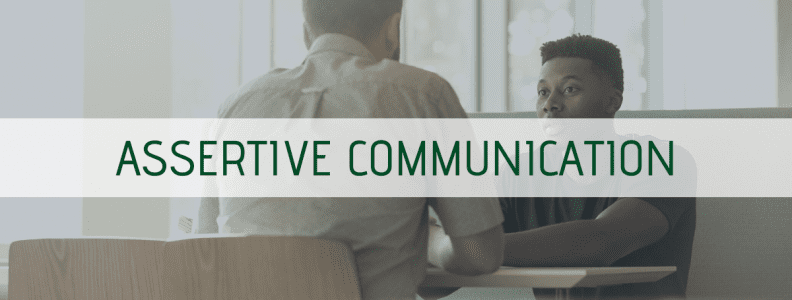How to Communicate to Heal, Not Hurt: Part 4
Finally, the best is last in our blog series. Assertive communication in addiction! There is a healthy way to communicate that can improve relationships and situations at home, at work, and everywhere. No method can guarantee success, but this one will improve the likelihood of a positive outcome. For families facing addiction and in recovery, assertive communication is a tremendous tool.
An Assertive Communication Scenario
Here is how assertive communication might look in an addiction intervention. Jack’s drinking is out of control. His wife Wendy has tried to bring it up, but Jack accuses her of overreacting. Wendy is trying again, after getting some coaching on how to use assertive language. Wendy (sits facing Jack and leans gently toward him, has a neutral facial expression, looks directly at Jack): “Jack, last night you didn’t call or come home and after 5 hours you did. I smelled alcohol on you and watched you pass out. I didn’t know where you were and I was really worried. This is happening a lot now. I am always scared. I am afraid you’ll be hurt. I am so anxious I can’t concentrate; I can’t function. I just don’t know what is happening anymore. I don’t feel like I matter to you anymore when you do this. I love you, Jack. I am asking you to get help. I need for you to get help. For yourself, but also for me. I hope and pray you will do this. I want you to know I will help you.” Jack (with raised voice and quick, agitated arm movements): “You’re overreacting again, Wendy! You worry too much, you don’t know what you’re talking about. I’m fine, I can handle myself. Stop judging me! If you’d quit judging me all the time, I’d probably be at home more.” Wendy (listens without interrupting, and then responds with calm tone): “I believe you Jack – that on some level you think you can do this alone, but I wonder if part of you isn’t so sure anymore. I don’t think anymore that you can do this alone. I know I couldn’t. I am so afraid for you, and for myself, and for us as a couple. But I do hear that you’re feeling judged. I don’t want that for you. I want you to feel how much I love you and that is why I am saying this. Jack, there is an office in town where we can go talk to someone for free about this. We both need this, and I am asking you to come with me.” This snapshot of assertive communication in action shows its features:
- Affirm our own rights as well as others’ rights
- Express feelings, needs and wants openly and honestly
- Act in our own best interest and also take into account the best interest of others
- Don’t try to make others uncomfortable or manipulate
- Willing to compromise
- Listen deeply – instead of thinking about your next remark, etc.
- Set limits and boundaries
- Take responsibility for ourselves
- Use “I” statements instead of judgmental “You” statements
- Use eye contact and body proxemics (posture, gestures etc.) that are confident but not threatening
An Assertiveness Formula
Notice all the “I” statements in this assertiveness formula, and how it progresses from observations on what happened, to thoughts about that, to feelings about that, to a request:
- DATA – “When I saw you… (e.g. come home drunk after being MIA and then passing out)”
- THOUGHTS – “What I think about that is… (e.g. it’s dangerous)”
- EMOTIONS – “What I feel about that is… (e.g. scared, anxious, like I don’t matter)”
- VULNERABLE REQUESTS (asking while realizing you may not get it) – “I would like… (e.g. please let’s get help with this)”
A very challenging part of this is the vulnerable request – we ask for what we need, knowing that we may not get it and understanding that we cannot control the outcome. Part of this aspect of assertive communication is internally asking what we need from ourselves as well, knowing we may not get what we need from the other.
Clarifying is Useful
When communication goes sideways, sometimes it is because we simply fail to understand one another. A good way to check for understanding is to clarify. Here are a few ways to do it:
- Repeat exactly what was said and get agreement that it was heard (“So you’re saying that…is that right?”)
- In your own words, summarize what you heard and ask if that is what they wanted you to hear
- Ask questions if anything is vague or could be interpreted in different ways (“When you said…what did you mean exactly? I want to be sure I understand you.”)
 Listening, Really Listening, is Key
Listening, Really Listening, is Key
Sometimes it seems listening is truly a lost art in these times, but it could not be a more important skill to regain. Effective listening is not just hearing the words, it is intention and effort to deeply understand the other person. It involves suspending judgment and your own agenda and paying close attention to the words, the vocalizations, the body language, and even what is not said. Here are some common blocks to listening that we all sometimes unconsciously do:
- REHEARSING– You do not listen at all, instead you are busy rehearsing what to say next. Your whole attention is on the crafting your next comment.
- COMPARING – You are busy trying to compare one person with another.
- MIND READING – Instead of paying attention, you try to figure out what the other person is really thinking and feeling in an effort to see through to the truth.
- FILTERING – When you filter, you listen to some things and not to others. You hear what you want to hear, and avoid what you don’t want to hear and let your mind wander.
- PREJUDGING – If you prejudge someone or label someone negatively, you do not pay much attention to what he says.
- DREAMING – You are half-listening, and something the person says suddenly triggers a chain of private associations. You are more prone to dreaming when you feel bored or anxious.
- IDENTIFYING – You take everything a person tells you and refer it back to your own experience. Everything you hear reminds you of something that you have felt, done, or suffered. You launch into your story before they can finish theirs.
- ADVISING – You are the great problem-solver, ready with help and suggestions. You do not have to hear more than a few sentences before you begin searching for the right advice.
- SPARRING – Your focus is on finding things to disagree with. One subtype of sparring is the put-down. You use sarcastic remarks to dismiss the other person’s point of view.
- BEING RIGHT – You will go to any lengths to avoid being wrong. You cannot listen to criticism, you cannot be corrected, and you cannot take suggestions to change.
- DERAILING – You change the subject suddenly. You derail the train of conversation when you get bored or uncomfortable with a topic.
- PLACATING – You want to be nice, pleasant, and supportive. You want people to like you – so you agree with everything. You half-listen, but you are not really involved.
Effective listening must start with you getting out of your own head and making the other person your focus. Then use your eyes, ears, brain and heart to seek to understand their experience.
Nonverbal Communication is over 90% of the meaning of the message
Assertive communicators also understand that words count for only 7% of the overall message. This seems quite unexpected but is well-researched. Our physiology, or body language, is actually the most influential part of communication, creating 55% of the message. And vocal tones create 38%. Nonverbal cues always speak louder than words, so assertive communicators manage their body language and vocal tones to be consistent with the words. This consistency strengthens and clarifies the message. (Check out this article from Very Well Mind for more information on non-verbal communication.) Think of the classic movie villain who is saying something “nice” but with a threatening voice, posture, and gestures. There is no doubt as to the meaning, and the words are not the real message. Nonverbals to be aware of include:
- Tone of voice
- Physical presentation
- Personal space
- Posture
- Facial expressions
- Eye contact
- Breathing
- Touch
- Gestures
Communication is Essential to Life
Our recovery program at Top of the World Ranch includes education on many topics, including this one. The goal of recovery is not just to kick substance use or behavioural addiction. Yes, that is the beginning, but the real goal is to become the very best version of yourself and live a truly meaningful life. Assertive communication is key, because the ability to form healthy and positive connections with individuals and communities is essential to living a full and purposeful life – and this is exactly the core of recovery.

